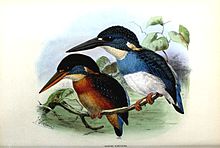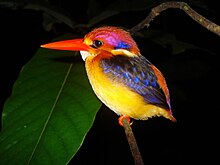Actual kingfishers
| Actual kingfishers | ||||||||||
|---|---|---|---|---|---|---|---|---|---|---|

Kingfisher ( Alcedo atthis ) |
||||||||||
| Systematics | ||||||||||
|
||||||||||
| Scientific name | ||||||||||
| Alcedininae | ||||||||||
| Rafinesque , 1815 |
The common kingfishers or Alcedininae are one of three subfamilies of the kingfishers family . The real kingfishers are widespread across Africa, East and South Asia and Australia. One species, the kingfisher ( Alcedo atthis ), is found in Northwest Africa as well as in Europe and northern Asia. The group includes many fish-eating (and diving) species of kingfisher. The origin of the subfamily is believed to be in Asia.
They are brightly colored birds that appear compact due to their short tail, large head and long beak . They eat insects or fish. The laying of white eggs takes place in self-dug brood tubes. Both parents are responsible for hatching and rearing the young.
Systematics
A molecular phylogeny analysis of the actual kingfishers from 2007 showed that the genera existing at the time were not monophyletic . The species were then grouped into four monophyletic genera. A clade from four species was grouped into the reinstated genus Corythornis . Five species ( Mangrovezwergfischer , Azur Kingfisher , Bismarck Kingfisher , silver Kingfisher , blue breast Kingfisher ) was in the genus Alcedo in the genus Ceyx arranged.
With the exception of one species, all kingfishers grouped into the restored genus Ceyx have three toes instead of the usual four. The exception is the Sulawesi dwarf fisherman , who has a rudimentary fourth toe.
The subfamily contains 40 or 41 species in 4 genera. The brown-headed dwarf fisherman is grouped by some authors in the monotypical genus Myioceyx , by others with the natal dwarf fisherman in the genus Ispidina . Molecular analyzes suggest that the Madagascar dwarf fisherman is closely related to the crested dwarf fisherman .
-
Ispidina - 2 types:
- Natal dwarf fisherman ( Ispidina picta )
- Brown- headed dwarf fisherman ( Ispidina lecontei )
-
Corythornis - 6 types:
- Madagascar dwarf fisherman ( Corythornis madagascariensis )
- White-bellied pygmy fish ( Corythornis leucogaster )
- Crested dwarf fisherman ( Corythornis cristatus )
- Sao Tomé pygmy fisherman ( Corythornis thomensis )
- Principezwergfischer ( Corythornis nais )
- Malegassian dwarf fisherman or black-billed dwarf fisherman ( Corythornis vintsioides )
-
Three-toed kingfishers ( Ceyx ) - 25 species:
- Talaud dwarf fisherman ( Ceyx sangirensis )
- Sulawesi dwarf fisherman ( Ceyx fallax )
- Gold dwarf fisherman ( Ceyx melanurus )
- Mindanao dwarf fisherman ( Ceyx mindanensis )
- Jungle dwarf fisherman ( Ceyx erithaca )
- Redback fisherman ( Ceyx rufidorsa )
- Philippine dwarf fisherman ( Ceyx margarethae )
- Moluccan dwarf fisherman ( Ceyx lepidus )
- Sulaz dwarf fisherman ( Ceyx wallacii )
- Buru dwarf fisherman ( Ceyx cajeli )
- Papuan dwarf fisherman ( Ceyx solitarius )
- Manus dwarf fisherman ( Ceyx dispar )
- New Hanover dwarf fisherman ( Ceyx mulcatus )
- New Britain pygmy fisherman ( Ceyx sacerdotis )
- Bougainville pygmy fisherman ( Ceyx meeki )
- New orgy pygmy fisherman ( Ceyx collectoris )
- Guadalcanal pygmy fisherman ( Ceyx nigromaxilla )
- San Cristobal dwarf fisherman ( Ceyx gentianus )
- Blue-breasted pygmy fish ( Ceyx cyanopectus )
- Indigo breast pygmy fisherman ( Ceyx nigrirostris )
- Platinum dwarf fisherman ( Ceyx flumenicola )
- Silver dwarf fisherman ( Ceyx argentatus )
- Azure dwarf fisherman ( Ceyx azurea )
- Bismarck dwarf fisherman ( Ceyx websteri )
- Mangrove dwarf fisherman ( Ceyx pusillus )
-
Alcedo - 7 to 8 types:
- Kingfisher ( Alcedo atthis )
- Turquoise Kingfisher ( Alcedo coerulescens )
- Chest banded kingfisher ( Alcedo euryzona )
- Hercules Kingfisher ( Alcedo hercules )
- Meninting Kingfisher ( Alcedo meninting )
- Blue banded kingfisher ( Alcedo peninsulae )
- Shining-blue kingfisher ( Alcedo quadribrachys )
- Cobalt Kingfisher ( Alcedo semitorquata )
features
All Alcedininae are short-tailed, large-headed, stocky birds with long, pointed beaks. Like other racks , they are brightly colored. The species of the genus Alcedo typically have metallic blue tops and heads and orange or white undersides. The sexes may look the same as in the Bismarck dwarf fisherman, but most species show a sex dimorphism that varies from differences in beak color as in the kingfisher ( Alcedo atthis ) to completely different looks. The male of the chest banded king size bird is white underneath with a blue chest band, while the underside of the female is orange.
The smaller kingfishers, which make up the rest of the subfamily, are blue or orange on top and white or yellow-brown on the underside with little differences between the sexes. Across the subfamily, the bill color corresponds with the diet. The insectivorous species have red beaks, while the beaks of the fish-eating species are black.
When erected, kingfishers sit fairly upright, and when they fly quickly they adopt a stretched position. The calls are typically simple high-pitched screams that are often uttered in flight.
distribution and habitat
Most of the real kingfishers live in warm climates in Africa and South and Southeast Asia. Three types occur in Australia; only the kingfisher ( Alcedo atthis ) lives in large parts of Europe and temperate-warm Asia. No species occurs in North or South America, although the green fishers are suspected of being descended from the real kingfishers. The origin of the subfamily is believed to be in South Asia, where most species still live.
The Ceyx and Ispidina species mainly inhabit moist rainforests or other forms of forest and are not necessarily bound to water. The Alcedo species are closely related to fresh water; they are often found in open habitats , although some are primarily forest species.
behavior
Brood
The real kingfishers behave monogamous and territorial. The couple digs a tube in a steep slope, in which the female lays two or more white eggs on the ground. Both partners breed and care for the young. The eggs are laid at one-day intervals so that only the older, larger nestling is fed when there is a shortage of food. The chicks are naked, blind and helpless when they hatch; they crouch on their heels - in contrast to any adult bird.
Ingestion
The small Ceyx and Ispidina species mainly feed on insects and spiders, but also eat tadpoles, frogs and mayflies - nymphs that are caught in pools of water. You are a flight catcher; their red beaks are flattened to aid in catching insects. The Alcedo species are typically black-beaten fish catchers, but also catch aquatic invertebrates, spiders and lizards. Some species are mainly insectivorous and have red beaks. Usually the fish are captured by diving after the bird has thrown itself from a branch; Kingfishers can also hunt jogging for a short time .
Individual evidence
- ↑ a b R.G. Moyle, J. Fuchs, E. Pasquet, BD Marks: Feeding behavior, toe count, and the phylogenetic relationships among alcedinine kingfishers (Alcedininae) . In: Journal of Avian Biology . 38, No. 3, 2007, pp. 317-326. doi : 10.1111 / J.2007.0908-8857.03921.x .
- ↑ Gill, Frank; Donsker, David, eds. (2017). "Rollers, ground rollers & kingfishers". World Bird List version 7.2. International Ornithologists' Union . Retrieved May 17, 2017
- ^ C. Hillary Fry, Kathie Fry, Alan Harris: Kingfishers, Bee-eaters, and Rollers . Christopher Helm, London 1992, ISBN 978-0-7136-8028-7 , pp. 8-9.
- ^ Robert G. Moyle: A molecular phylogeny of kingfishers (Alcedinidae) with insights into early biogeographic history . In: Auk . 123, No. 2, 2006, pp. 487-499. doi : 10.1642 / 0004-8038 (2006) 123 [487: AMPOKA] 2.0.CO; 2 .
- ^ A b C. Hillary Fry, Kathie Fry, Alan Harris: Kingfishers, Bee-eaters, and Rollers . Christopher Helm, London 1992, ISBN 978-0-7136-8028-7 , pp. 64-75.
- ^ A b C. Hillary Fry, Kathie Fry, Alan Harris: Kingfishers, Bee-eaters, and Rollers . Christopher Helm, London 1992, ISBN 978-0-7136-8028-7 , pp. 12-13.
- ↑ a b c C. Hillary Fry, Kathie Fry, Alan Harris: Kingfishers, Bee-eaters, and Rollers . Christopher Helm, London 1992, ISBN 978-0-7136-8028-7 , pp. 195-223.
- ^ C. Hillary Fry, Kathie Fry, Alan Harris: Kingfishers, Bee-eaters, and Rollers . Christopher Helm, London 1992, ISBN 978-0-7136-8028-7 , pp. 21-22.
- ^ C. Hillary Fry, Kathie Fry, Alan Harris: Kingfishers, Bee-eaters, and Rollers . Christopher Helm, London 1992, ISBN 978-0-7136-8028-7 , pp. 17-18.
Web links
- Kingfisher videos on the Internet Bird Collection
- Kingfisher sounds in the xeno-canto collection

